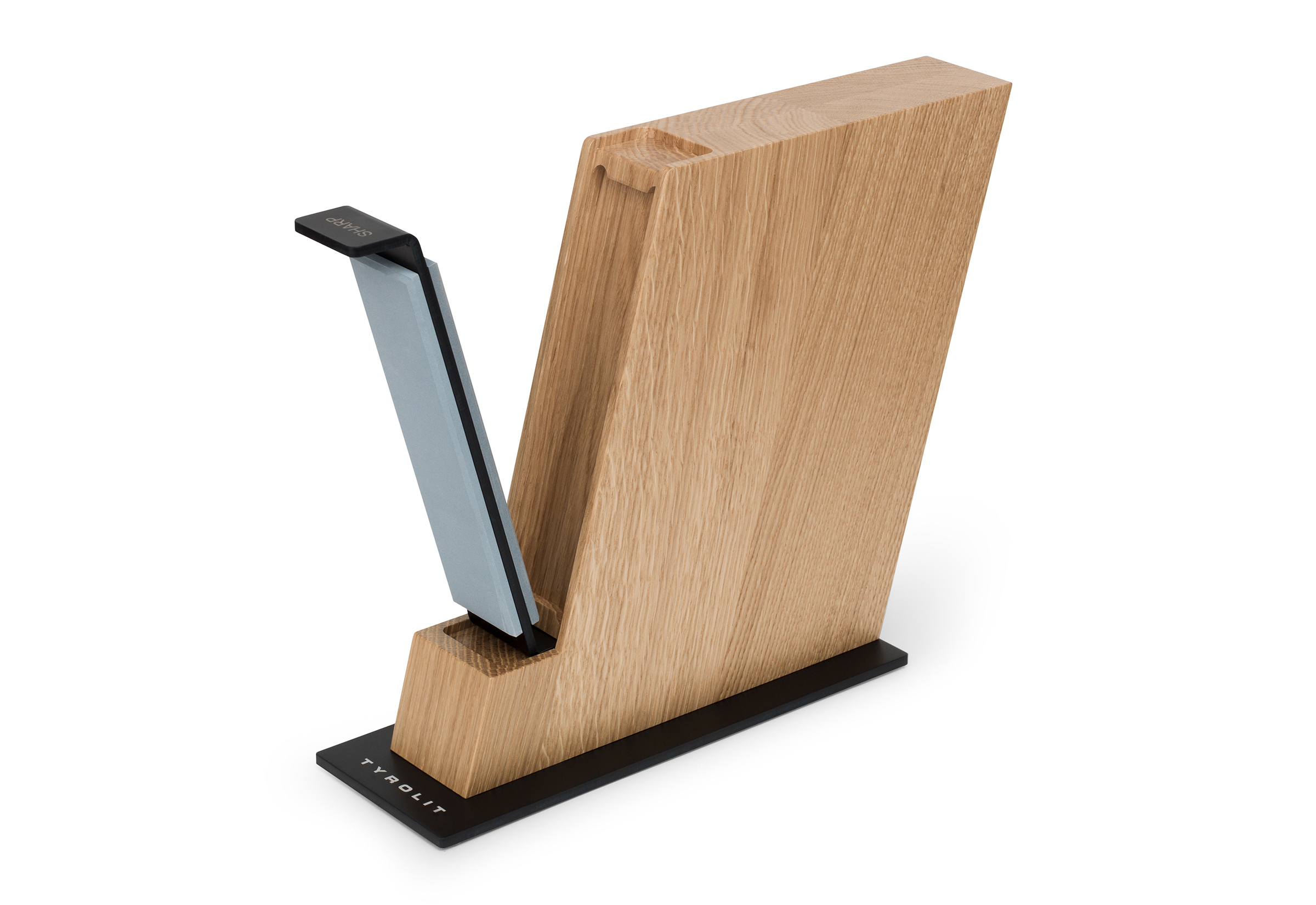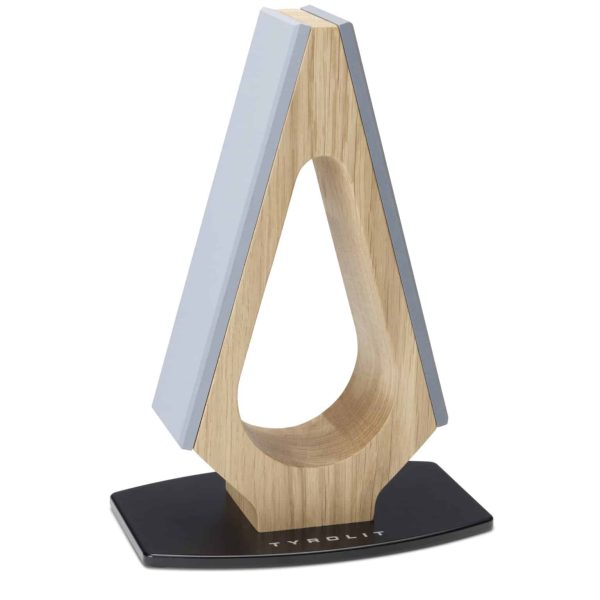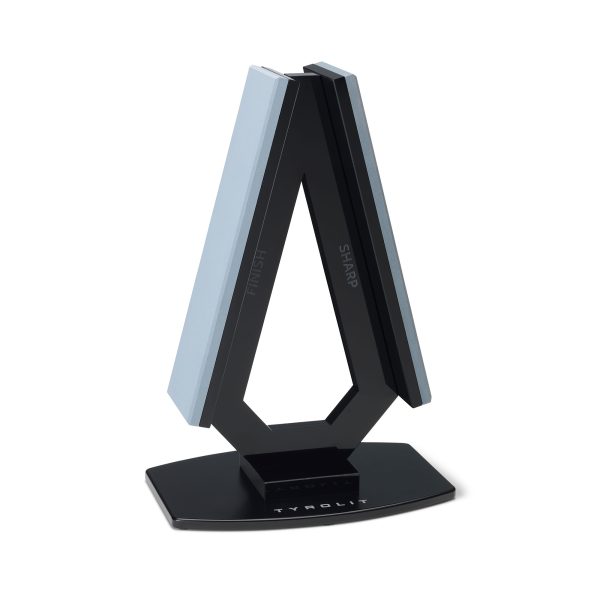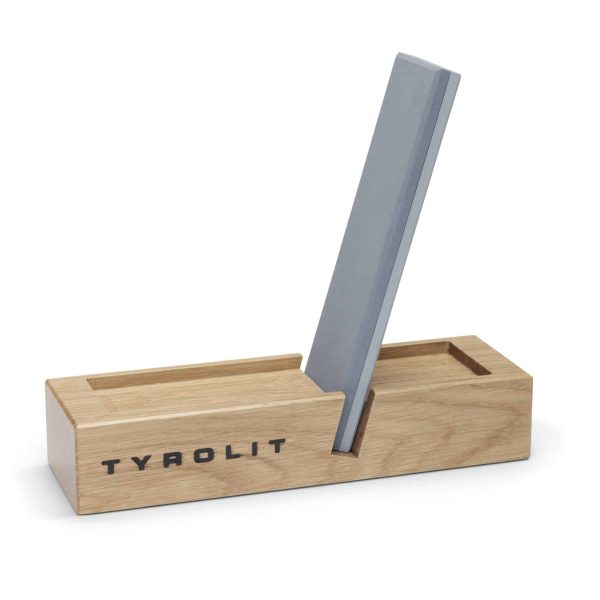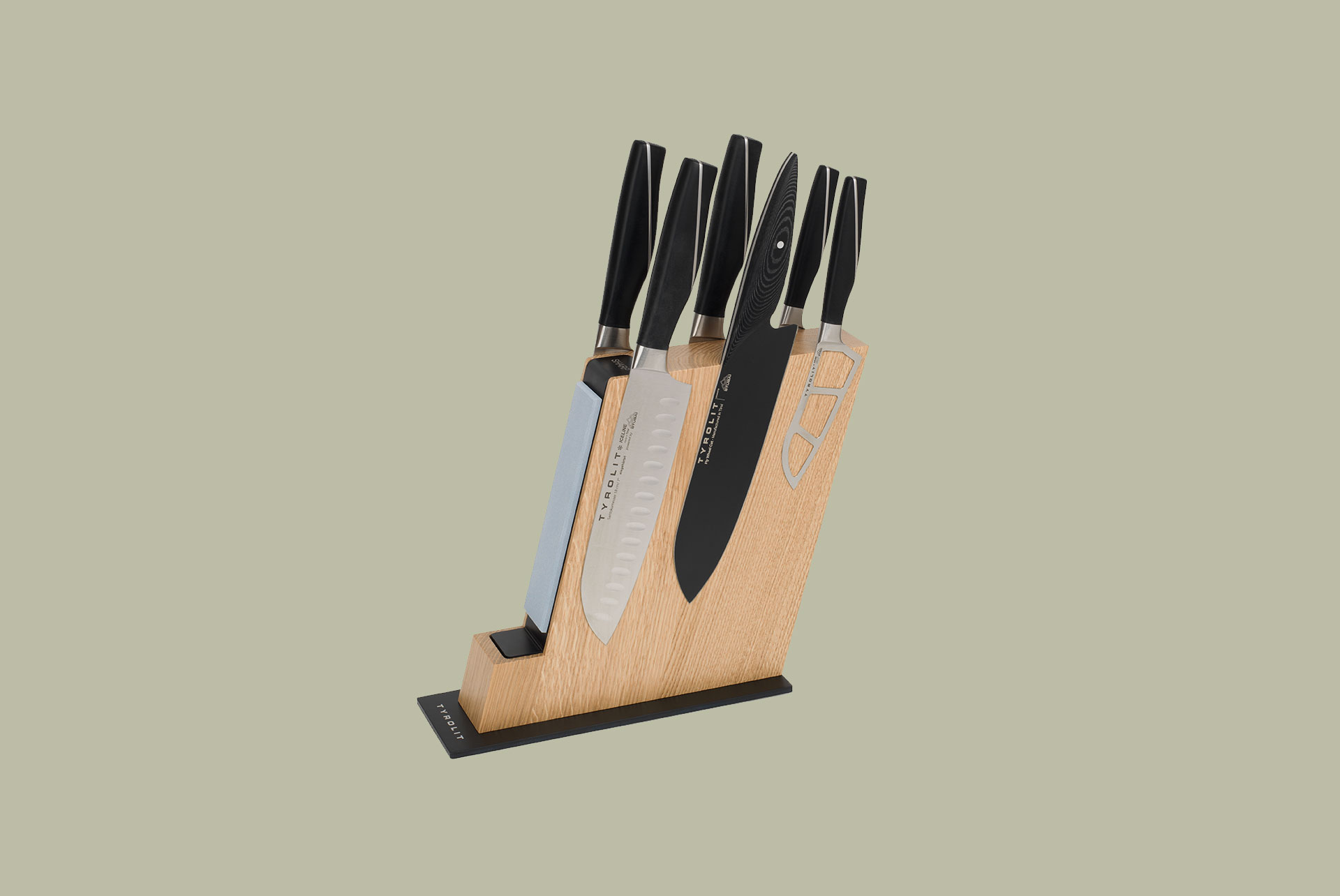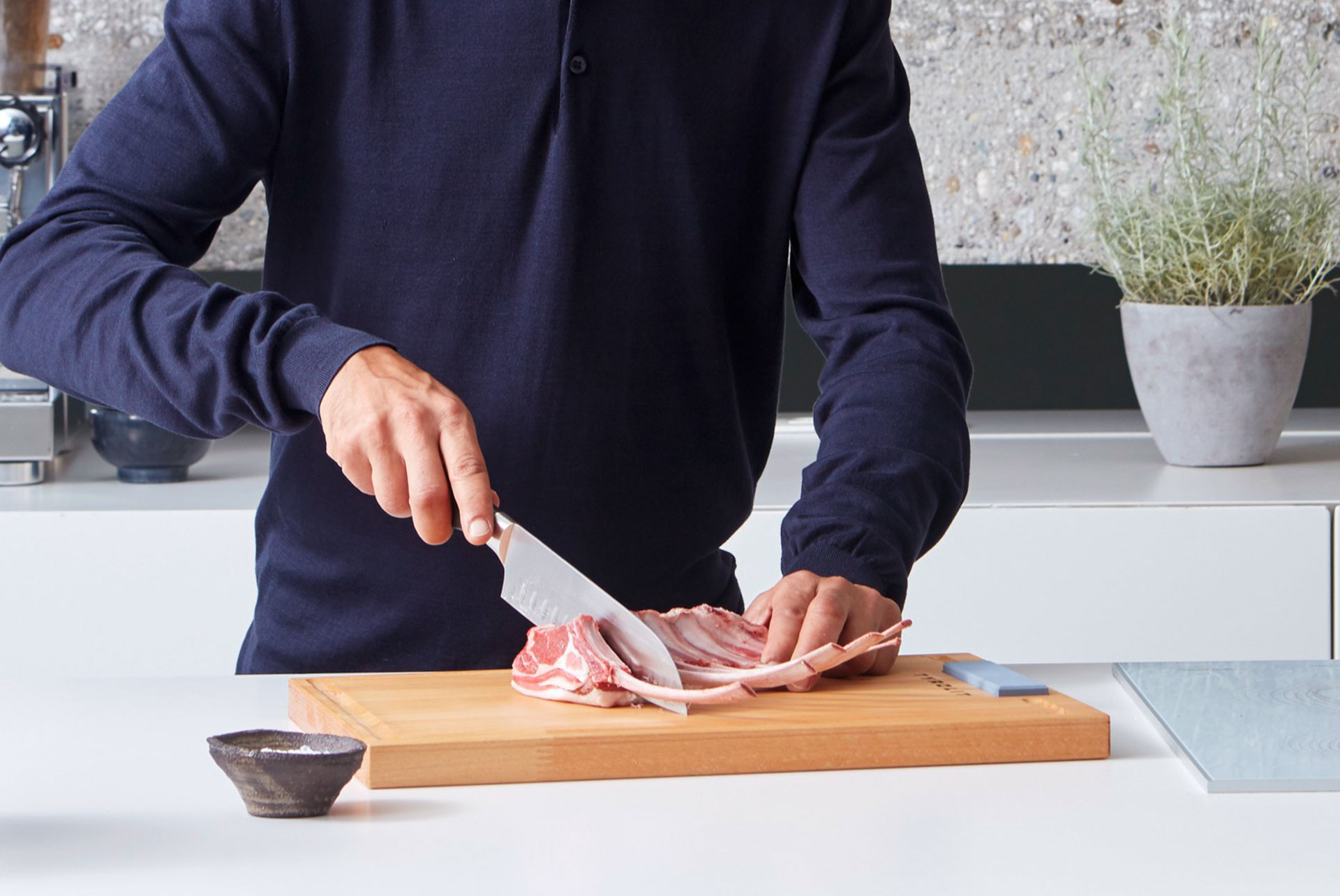Sharpening Instructions – 11 Tips for Sharpening a Santoku Knife
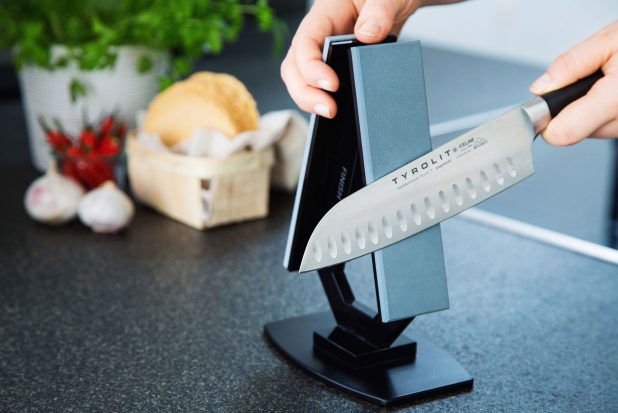
As experts in grinding and cutting tools at Tyrolit Life, we understand the importance of a sharp Santoku knife and other knives in the kitchen. These Japanese knives, Santoku knives, are known for their exceptional sharpness and precision. A well-maintained Santoku knife testifies to professionalism and passion in the kitchen but is also an essential factor for safety and efficiency in cooking.
Therefore, at Tyrolit Life, we place great emphasis on providing you with the finest tools and methods for sharpening your Santoku knife. Our knife sharpeners are crafted to be both effective and user-friendly. Whether you’re a professional chef or a home cook, our products are designed to help you achieve the ideal sharpness for your knives and maximize your culinary output.
In this article, we will show you how to keep your Santoku knife in top shape with the right Tyrolit Life techniques and tools. So we want to make it easy for you to maintain the sharpness and quality of your santoku knife so you can focus on what really matters – cooking and enjoying.
Sharpening and Grinding a Santoku Knife – What’s the Difference?
In dealing with kitchen knives, two key terms are imperative: sharpening and grinding. Although they are often used synonymously, there is a distinction
Sharpening refers to aligning and fine-tuning the knife edge to restore its original sharpness. This corrects the burr that forms at the cutting edge over time.
Proper grinding, on the other hand, means removing material from the blade to form a new cutting edge. This is especially necessary for heavily worn, very blunt or damaged blades.
However, it is important to note: Distinguishing sharply between the two terms is challenging. As a rule of thumb, the more material that is removed, the more it falls into the category of grinding. When only a minimal amount or no material is removed, it’s more aptly described as sharpening.
Sharpening Instructions – 11 Tips for Sharpening Your Santoku Knife

Sharpening and grinding is necessary from time to time with every Santoku knife. With a little practice, this process will soon become easy for you, and you may even discover the calming, meditative aspect of this process.
We have compiled 11 tips for you on how to get your Santoku knife razor sharp in no time.
1. Only sharpen clean knives!
Ensure that your Santoku knife is free from any contaminants before you start sharpening. Residues of fat or other food particles, as well as dish soap, can negatively impact the sharpening process and also harm your sharpening tools. Therefore, thoroughly rinse the Santoku knife and dry it with a clean cloth.
2. Wet the grindstones!
Before using the Tyrolit knife sharpener, it is important to wet the sharpening stones with water. During the later grinding of your santoku knife, this moisture will form a so-called grinding mucus. This is perfectly normal – just wipe it off when more of it has accumulated.
3. Ensure a firm surface and a secure footing!
Ensure a good stand and place your abrasive on a suitable surface. It is particularly important to prevent the knife sharpener from slipping during sharpening: this both prevents injuries and achieves more uniform results.
4. Choose the right sharpening angle!
Not every sharpening angle is suitable for every Santoku knife. Basically, you can distinguish between Japanese and European types for choosing the right angle. While the former tend to be sharpened at a sharper angle, European santoku knives – including the Tyrolit Life santoku knife – are sharpened at an angle of about 15° to give them more stability.
Be sure to accurately maintain the sharpening angle during sharpening – knife sharpeners with preset sharpening angles will help you with this.
5. Work evenly!
To achieve the most uniform result possible, you should sharpen the santoku knife uniformly from both sides. For each grinding stroke, work with constant pressure along the entire blade.
6. First comes the rough grind, then the fine grind.
The coarser the abrasive, the more material will be removed during grinding or sharpening. Utilize this knowledge by starting with a coarser grit for the foundational sharpening of your Santoku knife. This step is crucial, particularly if your knife hasn’t been sharpened in a while. Proceed to use a finer grit for the finishing or the final sharpening step.
To ensure both processes proceed as smoothly as possible, the Tyrolit knife sharpener combines two grinding stones with different grits (400 for coarse grinding and 800 for fine sharpening). Learn more about the types of sharpening stones and how they differ in shape, material, application, and grit.
7. Clean the knife after sharpening!
After sharpening – before the Santoku knife is put back into use or safely stored in the knife block – it must be cleaned. This way, you remove any grinding residues and maintain a clean, sharp Santoku knife that will impress you with its exceptional sharpness on its next use.
8. Polishing paste for the right finish
As is well known, we eat with our eyes first. To ensure that the aesthetics are up to par while cutting ingredients, you can reach for the polishing paste after sharpening and cleaning your Santoku knife. This way, you achieve a glossy surface and can also remove the burr that formed during the sharpening process.
9. Check result!
It may seem obvious, but it’s often overlooked: Check your work! After sharpening the Santoku knife, ensure you are satisfied with the results. There are multiple ways to do this: while methods like running the back of your hand across the blade pose a great risk of injury, you can simply perform a test by slicing a tomato in half. This allows you to practically – and safely – evaluate the success of your sharpening efforts on the Santoku knife.
10. Sharpen regularly, but do less at a time!
If you repeatedly allow your santoku knife to become completely dull, sharpening it next time will become a more substantial task. Furthermore, dull knives pose a safety risk in the kitchen, as they slip more easily and typically require greater pressure to cut. Instead, you should regularly hone your santoku knife— even during cooking sessions if you find yourself doing extensive cutting work. By doing so, you’ll only need to remove a minimal amount of material, if any, and always have a sharp blade at hand for tasks like precisely preparing a fillet.
11. Sharpen your Santoku knife with Tyrolit
As an expert in abrasive materials, Tyrolit provides the highest quality in its sharpening and grinding stones – for your Santoku knife, as well as for the broader range of knives. The innovative knife sharpeners offer ease of use with unparalleled precision. The outcome: absolute sharpness with every use. How you can comfortably sharpen your Santoku knife at home is demonstrated in the following video
Sharpening Santoku knives with Tyrolit Life Sharpeners
Sharpening your Santoku knife with a Tyrolit Life knife sharpener or knife grinder is a breeze: start by moistening the sharpening stones under running water.
The preset sharpening angle of 15 degrees enables you to achieve excellent sharpening results with minimal effort. Finding the correct angle is often the actual challenge when using sharpening stones. During the sharpening process, draw the blade of your Santoku knife across the sharpening segments at a 90-degree angle.
The sharpening stones come in two different grits (400/800). The 400 grit is suitable for initial sharpening, especially if your Santoku knife hasn’t been sharpened or ground for a while, or if the blade is dull. For finishing, use the 800 grit, which is ideal for fine-tuning the sharpness of your Santoku knife during cooking or adjusting the blade’s edge.
Be sure to sharpen the blade evenly on both sides for a perfect result. The precisely designed grinding aid and the use of high-quality materials ensure that you achieve optimum sharpness with little effort.
Finally, rinse the blade briefly with running water to remove any residues. After drying, your santoku knife is ready for any cutting work.

Tyrolit Life Knife Sharpener – Benefits at a Glance
The Tyrolit Life knife sharpeners are designed to enable effortless and effective sharpening of your kitchen knives, whether you are a beginner or an experienced kitchen professional. In addition, the blade polish offers the possibility to polish your kitchen knives and make the stainless steel shine.
- Easy to use: These knife sharpeners are fast and safe to use and do not require much effort. Sometimes you do not need a second hand and can quickly sharpen your santoku knife during cooking.
- Fixed sharpening angle: The sharpening angle is fixed at 15 degrees, which makes sharpening easier and allows for perfect results.
- Different Grits: The combination stone with 400/800 grit enables the precise adjustment of sharpness levels, where the coarse grit is perfect for rough grinding and the finer grit for fine sharpening and polishing the blade. This effectively restores the sharpness of even the dullest Santoku knives.
How important is it to sharpen your santoku knife regularly?
A sharp santoku knife is essential for precise cuts and efficient kitchen work. However, over time, each blade loses its sharpness, which can lead to uneven cuts and an increased risk of injury.
Regular sharpening and realigning the blade's edge with high-quality tools like Tyrolit Life knife sharpeners ensure that your knife always performs at its best. If you own a high-quality Santoku knife, often you only need to adjust the blade's angle with the knife sharpener or honing steel. Then, your Santoku knife will effortlessly slice again.
Storing Santoku Knives – Correct and Safe Storage
Proper storage not only protects the blade from damage and wear, but also contributes to the safety in the kitchen. In this article, we will therefore present various methods of Santoku knife storage and explain how you can optimally protect and care for your knife.
How often does a high-quality Santoku knife need to be sharpened?
The frequency at which a high-quality Santoku knife needs to be sharpened depends on two key factors: the quality of the materials and the craftsmanship. Unlike sharpening or realigning the blade's edge, however, grinding a knife is significantly less required.
With a first-class all-purpose knife such as the santoku knives from Tyrolit Life, which are made from one piece of high-quality stainless steel, the blade remains sharp and resistant for longer due to its precise processing. Such a knife wears out more slowly and must therefore be sharpened less frequently.
Another important aspect is the regular care of the blade by sharpening. The more often the blade is sharpened, the less often comprehensive sharpening by a professional sharpening service becomes necessary. Regular care thus contributes significantly to the longevity and sharpness of your high-quality santoku knife.
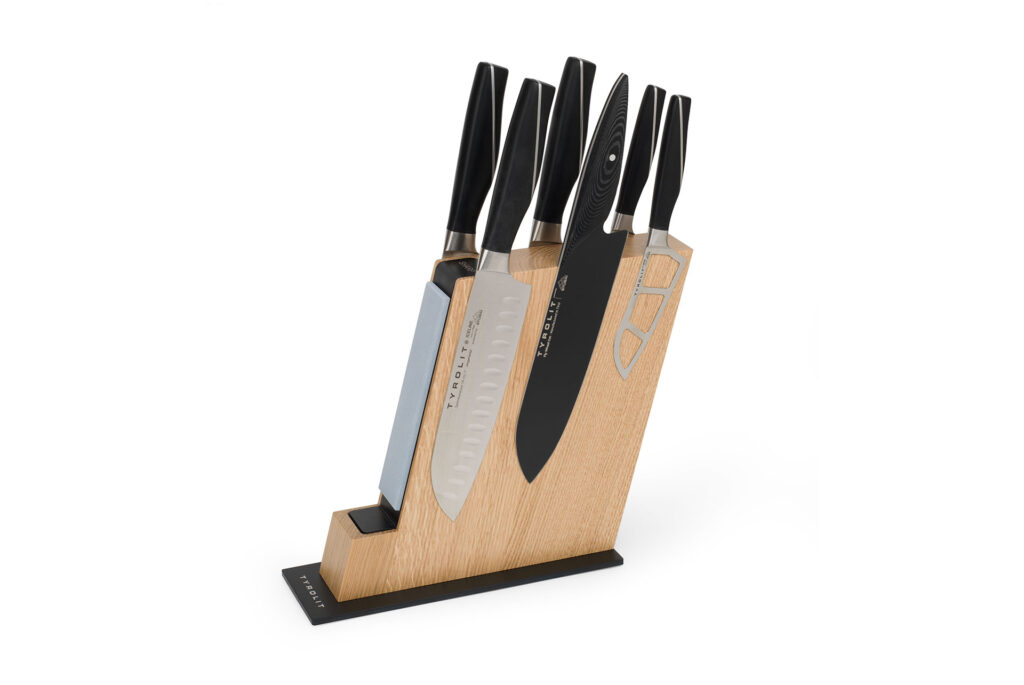
What makes a santoku knife blunt?
The sharpness of a Santoku knife can be diminished by various factors. The most common reason a Santoku knife becomes dull is due to regular use, during which the blade incurs microscopic damage. Frequently using a knife sharpener can remedy this.
But the type of cutting pad also plays a role; hard surfaces such as steel or stone accelerate the wear process. Cutting boards made of wood or plastic are softer and better for the knife blade.
Improper storage of your santoku knife, such as keeping it loosely in a drawer where the blade may collide with other objects, can also lead to dulling. Using a leather blade guard or a magnetic knife block is recommended for the storage of your santoku knife and other kitchen knives.
The cleaning of your Santoku knives in the dishwasher or the use of aggressive detergents should be strictly avoided. This can damage the blade and diminish its sharpness. Therefore, to preserve the santoku knife's edge, meticulous handling and maintenance are crucial, as is ideally cleaning it by hand.
What makes a santoku knife blunt?
A Santoku knife is renowned for its sharp blade and precision, yet over time, even the finest knife can become dull. There are several factors that contribute to the dulling of the blade. Learn more now!
Proper Storage of Santoku Knives – Knife Block
Proper storage is essential for the care and longevity of a santoku knife. The knife block from Tyrolit Life offers the ideal solution for this. Made of high-quality, native oak, this magnetic knife block combines safety, sharpness and style in one product.
The integrated magnets ensure that your knives are stored safely and gently, while the built-in knife sharpener with preset sharpening angle simplifies the care of your knives.
The Tyrolit Life knife block is not only a practical addition to the kitchen, but also a visually appealing piece. Available in two color variants – silver and black – it seamlessly matches the design of your kitchen and provides space for up to six knives with blade lengths of up to 23 cm. With this knife block, you not only store your Santoku knives safely and stylishly, but also ensure they remain always sharp and ready for use.
Are you interested in a new Santoku knife? Discover, What exactly is a Santoku knife?


